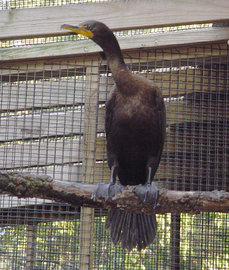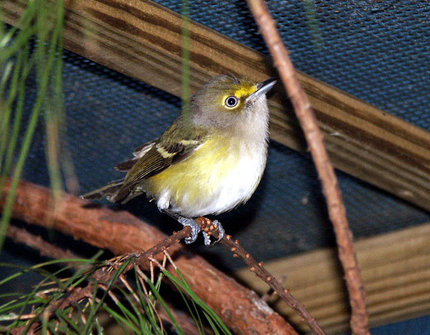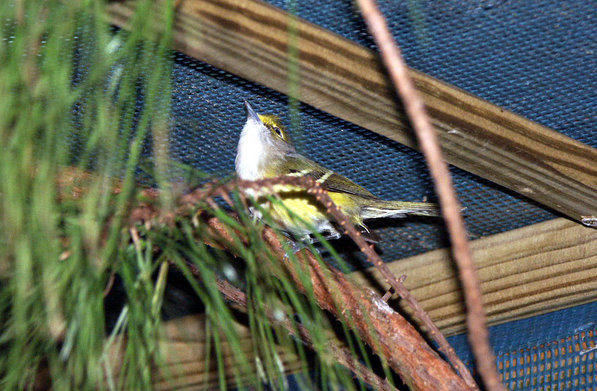August 22—A sympathetic Blount County resident sees a large brown bird with webbed feet and hooked beak walking down a street in downtown Oneonta. The bird appears to be dazed, exhausted, and badly overheated, and she has been able to corner it in a doorway and place it in a dog crate . . .
 |
 |
 |
October 11—A report of a small greenish bird with a light-colored eye that has been found at a gas station in downtown Tuscaloosa. The bird is alert, but cannot fly, and one leg appears to be injured. . .
 |
 |
 |
And the mystery patient is . . . a White-Eyed Vireo. The badly-injured bird had been kept a day without care or nourishment before the finder brought it to us for treatment. Since the Vireo was unable to stand, an AWC staffer fashioned a “donut” from folded fabric to support its body until it regained the strength to perch on its own. Vireos catch insects on the wing, so unlike ground-feeding birds such as Robins, Vireos lack the instinct to take food from a dish. Katie fed the bird cut waxworms, kitten kibble and homemade suet with hemostats until it mastered the skill of picking up food from a dish. A feeling of security is important to reducing stress, which can be fatal to small birds. So the staffer furnished the Vireo’s enclosure with plenty of leafy branches to hide in. When the little bird gained enough strength to begin perching, the left leg was still weak, and the bird had trouble retaining its perch. Within less than a week, both legs were firmly grasping the perch, and the bird was beginning to make short flights. The badly injured Vireo is making a miraculous recovery, and will soon be moved to an outdoor enclosure in preparation for release on the Gulf Coast.
Update November 28 -- The now-healthy Vireo was released on Thanksgiving Day in Bon Secour National Wildlife Refuge.
October 19—A Riverchase resident brings in a large domestic goose that has a baseball-sized tumor hanging beneath its chin. The bird appears strong despite the huge growth, and we suggest that the residents of the lake where the bird lives should take the bird to a veterinarian and pay for the necessary medical treatment. The gentleman says no one is willing to pay even a small amount for the bird’s treatment. . .
And the mystery patient is . . . The large domestic goose that was brought to us with a baseball-sized tumor hanging beneath its chin needed immediate surgery. Although our mission is limited to the care of native wildlife, we receive many domestic ducks and geese that need fishing hooks and fishing line removed. Usually we can care for them without having to ask our volunteer veterinarians to perform costly surgical procedures. The goose’s condition was so serious, however, that we asked Dr. Alvin Atlas of Riverview Animal Clinic to donate his services since the residents around the lake were unwilling to pay for the surgery. Although the large mass was cancerous, the surgery was uneventful, and the incision healed rapidly. The goose was ready for release less than a week later. After a final few days in AWC's pool, the goose was reunited with its long-time companion, a white duck residents call "Aflac," back on its home lake. The residents have agreed to take the goose to Dr. Atlas for a follow-up visit later this month.
November 3—An unusual-looking woodpecker is found on Inverness Parkway at 6:30 a.m. An office worker finds the bird and attempts to release it, but although the bird appears undamaged, it cannot fly. . . .
And the mystery patient is . . . a Yellow-Bellied Sapsucker, a beautiful northern woodpecker that winters in Alabama. A night migrant, the bird was probably injured by a collision with a lighted office window. Estimates are that close to a billion birds are killed each year by colliding with glass windows. Dazed from the collision, the Sapsucker refused at first to eat, although it readily consumed drops of a nutritious formula high in calories and fat, electrolytes and vitamins. The fluid is offered with a small syringe every two hours. The Sapsucker feeds by drilling a row of small holes in tree bark. As sap drips out, the Sapsucker feeds on the sap and also on insects attracted to the sweet liquid. We have noticed with other Sapsuckers that they drink our formula eagerly—perhaps it tastes like sap! As of this writing, the bird still requires frequent hand feedings. The woodpecker was suffering from a fracture of the left coracoid bone, one of the important bones anchoring the flight muscles. A special body-wrap will remain in place for at least 10 days.

